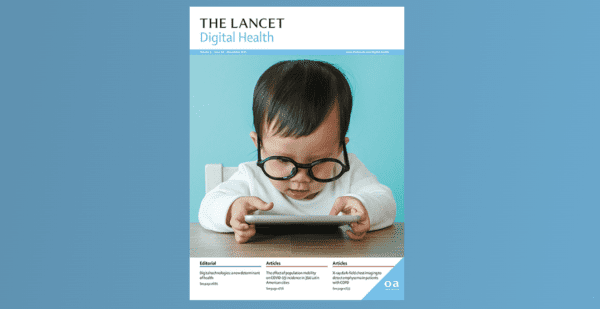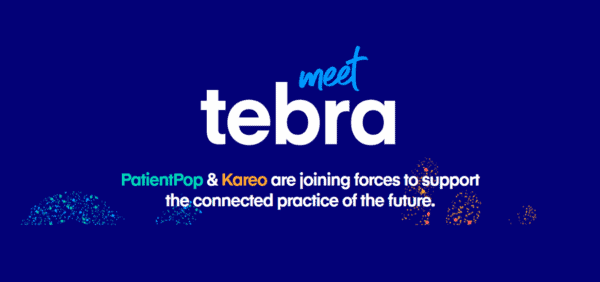|
Digital Health Study | Tebra Merger
November 4, 2021
|
|
|

|
|
Together with
|

|
|
|
“The one thing our customers have been asking for over the years is a deeper integration with their clinical and financial system of record.”
|
|
Luke Kervin, co-CEO and co-founder of PatientPop
|
|

|
|
Medical researchers have typically relied on self-reported health data to establish patient metrics such as activity levels and heart rate, but a recent paper published in the Lancet by Michigan Predictive Activity & Clinical Trajectories in Health (MIPACT) aims to form a sturdier baseline for future digital health interventions.
The study is unique in its large sample size (n = 6,765) and the scale of collected information, capturing health data from underrepresented age groups, races, ethnicities, and underlying conditions.
While the preliminary results include only the first 90 days of the ongoing three-year observational study, the authors published the aggregated data to allow for comparison of groups (age, race, ethnicity, gender, body-mass index, beta-blocker use, medical conditions) to longitudinal patterns of activity, heart rate, and blood pressure data.
- Methods – The study enrolled a diverse set of 6,765 US adults (54% women, 18% 65 or older, 17% Black, 17% Asian) of whom 10% have diabetes, 33% have hypertension, and 27% have depression. Participants were provided Apple Watches, Omron blood pressure cuffs, and a MyDataHelps smartphone app to record data on heart rate, blood pressure, step counts, and distance walked.
- Results – A total of 200m heart rate measurements and 1.1m blood pressure readings were collected over the 90 day period. Participants 65 and older had significantly lower heart rates, while women had average resting heart rates 3 bpm higher than men. Heart rates and activity levels varied by race, ethnicity, and underlying conditions, underlining the importance of patient-specific context when interpreting data from wearables.
- Discussion – Researchers noted that upon the study’s completion the participant data will span from before the pandemic to after its onset, enabling the evaluation of its impact on physiologic parameters due to illness and lifestyle changes.
Study Impact
Wearables have made longitudinal vitals monitoring a reality, allowing clinicians to paint a more complete picture of patient activity in daily life. As the study continues with its three-year monitoring phase, MIPACT intends to contextualize the patient data with information from EMRs and surveys, furthering its goal of creating better baselines for future digital health research. In the meantime, the authors hope that the easily navigable preliminary results will be used to improve study design and clinical recommendations.
|




|
|

|
|
Cloud-based software developer Kareo and private practice growth company PatientPop announced the closing of their merger and unveiled the combined company’s new name, Tebra.
Tebra currently supports over 100k providers and is looking to combine the technology of both companies to help modern private practices along every step of the patient journey.
- PatientPop helps physicians grow their practices through marketing assistance, virtual scheduling, and an online platform to practice care remotely. The company offers cloud-based solutions that automate tasks such as scheduling and referrals to grow bookings.
- Kareo provides software that supports EHRs and financial services for independent practices. The technology includes features supporting practice management, patient engagement, and third-party app connectivity.
- Tebra, as in “vertebrae,” aims to be the backbone of private practices, integrating PatientPop’s growth solutions with Kareo’s operations tech to allow physicians to work at the top of their licence while meeting the rising patient expectations for seamless digital experiences.
- Advantages of scale might emerge as Tebra continues expanding its client base, such as networking its physicians to drive more referrals, or even the possibility of facilitating consolidation of the offices it helps grow.
Industry Impact
As healthcare systems invest heavily in digital innovation, Tebra’s practice management platform is a lifeline for private practices trying to keep up. Without the financial buffer of larger systems, independent physicians were severely impacted by the post-pandemic declines in patient volumes, and offloading administration and growth functions onto a company like Tebra could be a piece of the solution.
|




|
|
Nuance’s Patient Engagement Must-Haves
Consumer demands are shifting, and they’re looking to get more out of their digital health technology. Nuance outlines the 5 must-haves for your patient engagement strategy here.
|
|
- Notable Series B: Healthcare automation company Notable raised a $100m Series B round ($119m total funding) to build out its platform that leverages AI to continually scan provider EHRs and other applications to identify automated workflows to perform (pre-visit registration, authorization requests, patient reminders). Notable aims to impact the $1t of annual administrative burden involved with manual and repetitive workflows, an area that’s been getting a lot of attention as the healthcare worker shortage continues.
- Data Trust Issues: A survey of 100 healthcare executives from medical technology company InterSystems found that 85% of organizations see data analytics as key to achieving strategic objectives, yet only 20% fully trust the data that informs their decisions. Respondents pointed to integration and interoperability as the greatest barriers to successful analytics. These struggles were more common for larger health systems with extensive data sets, making them more likely to invest in data solutions due to their greater needs.
- Eliminating Health Disparities: The American Telehealth Association launched the first phase of its initiative to assess how telehealth can help eliminate health disparities in the US, which involved forming an advisory board of dozens of healthcare organizations co-chaired by Optum, GEHA Health, and MCIC Vermont. Over the next year, the group will outline a series of steps designed to improve access to care by addressing barriers such as connectivity and health literacy.
- Rheumatology’s In-Person Advantage: The UK’s rheumatology clinicians and patients largely prefer in-person consultations over telemedicine. Surveys and interviews completed between April 2021 and July 2021 (n = 111 / 29 clinicians, 1,340 / 31 patients) revealed that many clinicians and patients felt that telemedicine was worse than face-to-face for building trust (90% & 69%), clinicians’ ability to listen (50% & 50%… <10% rated it better), and assessment accuracy (93% & 86%). As expected, many viewed telemedicine visits to be more convenient (60%).
- Wellinks COPD Funding: Wellinks recently closed $25m in Series C funding ($43m total funding) that it will use to continue developing its virtual solution for treating chronic obstructive pulmonary disease (COPD). The company integrates hardware such as pulse oximeters with a mobile app for reporting symptoms and connecting with rehabilitation coaches, an all-in-one solution that could give the company an advantage over more fragmented products.
- Digital Health Equity: A new viewpoint from researchers at UC San Francisco provided a socioecological framework for digital health equity that takes into account domains such as communities and public policy, while providing examples of inequitable system design. As an example, although many digital solutions are targeted at patients with diabetes, few studies evaluate the effectiveness of such solutions in marginalized populations who experience a disproportionate burden of chronic disease in the US.
- AI Assistant Scheduling: Cleveland-based health system University Hospitals, which operates 150 hospitals, outpatient centers, and primary care facilities, is deploying an AI-powered virtual assistant from Interactions to help field the 1.7m scheduling calls it receives each year. The assistant is designed to capture intent, identify + authenticate, then help provide scheduling self service for patients in order to reduce wait times and accidental misdirections.
- mHealth Depression Study: A recent study in JMIR mHealth and uHealth equipped 122 youth participants with an app that recorded activity data over 2 weeks to determine if there was an association with depression, finding that depressive symptoms correlated with more time spent stationary (r=0.293), less mobility (r=0.271), and fewer outgoing calls (r=−0.244). The work indicates that passively collected data may help with earlier detection of depression in youth without the need for specialist visits.
- Telehealth Use: FAIR Health’s Monthly Telehealth Regional Tracker showed that telehealth use among privately covered individuals rose 2.4% month-over-month in August, with the South significantly outpacing other regions through a 12.9% gain. COVID-19 also entered the top five national telehealth diagnoses for the first time since January 2021, which might suggest that the increase in telehealth use has been propelled by patients seeking a care venue with a lower risk of disease transmission
- Hospital Margins Decline: Kauffman Hall’s latest National Hospital Flash Report showed that median hospital operating margins declined 18% from August to September, primarily due to lower inpatient and outpatient volumes as the pandemic causes many to defer care. Total hospital expenses remain elevated at 10% above prepandemic levels as labor shortages and supply chain issues add further pressure to margins, trends that are unlikely to subside in the near term.
|
|
|
|
|